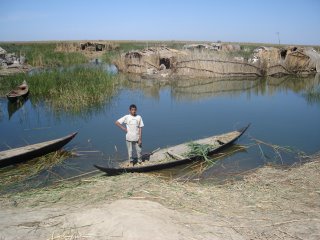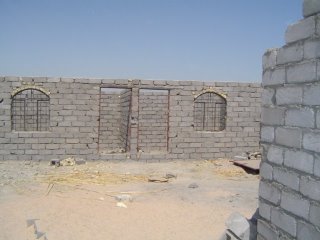This image was taken earlier this year. But it could have been taken in the 1970s. It looks much the same.

A lot has happened in the interim though. For starters the previous regime destroyed their villages with aerial bombardment and bulldozers, killing and displacing thousands. Hundreds were taken away to Northern Iraq and executed according to Human Rights Watch. The marshes were drained and desertification ensued. Thousands became refugees, predominantly in Saudi and Iran.
Since 2003, swathes of the marshes have been reflooded (albeit in an uncoordinated way and with polluted water) and thousands of Marsh Arabs have returned. Despite a slow ecological recovery there's been an attempt to restore old livelihoods and ways of life. Magnificent meeting houses are built out of reeds, homes are still built on mounds of mud and reeds, and people still depend on fishing, reed crafts and water buffalo for their livelihoods. Most communities lack water, sanitation, electricity, health clinics and schools. In many respects it's a very different world to that images of violence and destruction in urban areas. It's not a great place to grow up as a child. Conservative values and tribal loyalities pervade which on the one hand creates protection and increases resiliency to social and family breakdown, and on the other hand promotes inter-tribal conflict and harmful practices like early and forced marriage.
But there are encouraging stories.

In one of the communities we work with, parents had pooled together their savings to rent a reed house to serve as a school for their children. Sadly, the landlord has just terminated the tenancy but it showed that parents were thinking about their children's future, willing them to have a childhood and the foundations for the a life before their subsistence living and state dependency.
In another, we've just set up a cement brick making community project for $5,000 which is proving a great success. In just a couple of weeks they've produced over 4,000 cement bricks which are being used to build school rooms and construct homes. They're sold to the community at cost and to outsiders for profit, with the profit going into a fund for vulnerable families in a similar way to a zakat payment. And it's creating employment... Much better and cost effective in my mind than a multi million dollar construction programme that brings in external contractors to build new homes that cost $20,000 each due to government standards.

A lot has happened in the interim though. For starters the previous regime destroyed their villages with aerial bombardment and bulldozers, killing and displacing thousands. Hundreds were taken away to Northern Iraq and executed according to Human Rights Watch. The marshes were drained and desertification ensued. Thousands became refugees, predominantly in Saudi and Iran.
Since 2003, swathes of the marshes have been reflooded (albeit in an uncoordinated way and with polluted water) and thousands of Marsh Arabs have returned. Despite a slow ecological recovery there's been an attempt to restore old livelihoods and ways of life. Magnificent meeting houses are built out of reeds, homes are still built on mounds of mud and reeds, and people still depend on fishing, reed crafts and water buffalo for their livelihoods. Most communities lack water, sanitation, electricity, health clinics and schools. In many respects it's a very different world to that images of violence and destruction in urban areas. It's not a great place to grow up as a child. Conservative values and tribal loyalities pervade which on the one hand creates protection and increases resiliency to social and family breakdown, and on the other hand promotes inter-tribal conflict and harmful practices like early and forced marriage.
But there are encouraging stories.

In one of the communities we work with, parents had pooled together their savings to rent a reed house to serve as a school for their children. Sadly, the landlord has just terminated the tenancy but it showed that parents were thinking about their children's future, willing them to have a childhood and the foundations for the a life before their subsistence living and state dependency.
In another, we've just set up a cement brick making community project for $5,000 which is proving a great success. In just a couple of weeks they've produced over 4,000 cement bricks which are being used to build school rooms and construct homes. They're sold to the community at cost and to outsiders for profit, with the profit going into a fund for vulnerable families in a similar way to a zakat payment. And it's creating employment... Much better and cost effective in my mind than a multi million dollar construction programme that brings in external contractors to build new homes that cost $20,000 each due to government standards.



No comments:
Post a Comment